Know how to clean old aquarium gravel in these best ways can help you to purify your fish tank substrate without hurting the good bacterias inside for your fish development.
One of the most essential things to care about a new fish tank is the substrate. Many people prefer gravel to set up a more beautiful scenery for their aquarium compares to other kinds of substrate materials.
Though, how important the gravel is in the fish tank can make lots of fish raising beginners confusing since people usually use gravel only for decoration. It has more great uses for fish development that could be affected if you don’t know how to clean old aquarium gravel in the right way.
No matter if you buy a new used fish tank or clean the tank you are using right now, this guide for how to clean old aquarium gravel can give the best care for your fish.
Useful information about aquarium gravel for every fish lover
1. Why Should I Choose Gravel As My Fish Tank Substrate
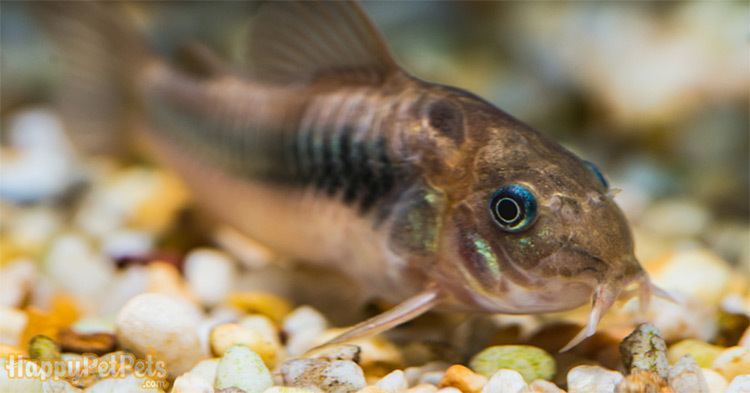
Gravel is a place for fish to play, reduce stress as well as raise the beneficial bacteria for your fish development
Although gravel is not a must-have item in the fish tank, there are a lot of reasons why it could be great for your fish.
The most important function is gravel provides a good place that beneficial bacteria can live. Lots of waste run out in the water every day, it can be fish waste, debris, leftover fish food, dead plants and so on, which not only pollute your fish living environment but also easier to increase ammonia level and give a threat to the fish lives.
Without gravel, of course, good bacterias can find another place to live, but the-other-place will not be able to offer a better place than the gravel do, this leads to a lack of helpful bacteria quantity needed for your fish tank.
In addition, gravel can help to reduce fish stress, which is also essential for fish growth. Gravel substrate protects the new fish eggs laid from mature fish attack as well as the plant roots in the tank can get enough place, nutrition and have a healthy life.
2. Which Types Of The Substrate Are Good For The Fish

Sand substrate is also good for fish, but it provides less good bacteria and visual effect for your fish tank than the gravel substrate
Comparing non-substrate, sand vs. gravel:
Non-substrate:
- Doesn’t cost money for preparing. You can clean the tank easier while preventing other unexpected animals in the aquarium.
- Your fish will not have a place to interact with. The aquatic plant is harder to set up, as well as it can take more effort to decorate the tank. No biological filter meaning that you need to change the water more frequently.
Sands substrate:
- Give your fish tank a more natural look. The sand substrate will not hide the extra-food left in the water. It is cheap and safe for your fish to move around.
- Sands substrate is not suitable for all kinds of plants. Because of its high-density texture, it will lack oxygen, nutrition, good bacteria as well as push the fish waste faster, which means more cleaning and fertilizing time.
Gravel substrate
- Create a better environment for fish, plant and beneficial bacteria. It helps the water stay clean longer, take less effort to clean up the tank. Gravel can be a biological filter and make your aquarium look nicer, too.
- Cost for the gravel. It hides the uneaten food and other waste more than the sand substrate. Easier to get algae and hurt the fish if the gravel is a low-quality one.
Based on the fish types, your decorations and the cleaning frequency you want, you can choose a fitting substrate for your aquarium.
3. How Much Gravel For Aquarium is Needed

The aquarium gravel layer height is based on your fish and decoration mostly
To find out how much gravel for aquarium is suitable, you should first consider what your fish and plant prefer, as well as how you will decorate the tank.
The gravel layer must high at least 1 inch, you can choose a 2 inches height for most tanks. This tool will show how much gravel for fish tank that you need to prepare due to the tank size.
For example, if your tank size is 40 gallons with 19 by 12 inches, the gravel layer height is 2 inches, you will need nearly 23 pounds of gravel to fill the bottom.
4. What Kinds Of Gravel To Choose For The Tank
Gravel is quite easy to set up, along with its colourful types, which is much more convenient for you to decorate the fish tank.
Gravel has some basic colors like:
- White aquarium gravel
- Black gravel aquarium
- Green aquarium gravel
- Pink aquarium gravel
- Blue aquarium gravel
You can choose even more colors from brands like Glofish or Marina to upgrade the tank presence. Alongside, glass gravel for aquarium is a great choice to get more light effects.
Read more: Best Fish Tanks 2019: Our Top Picks For Every Budget
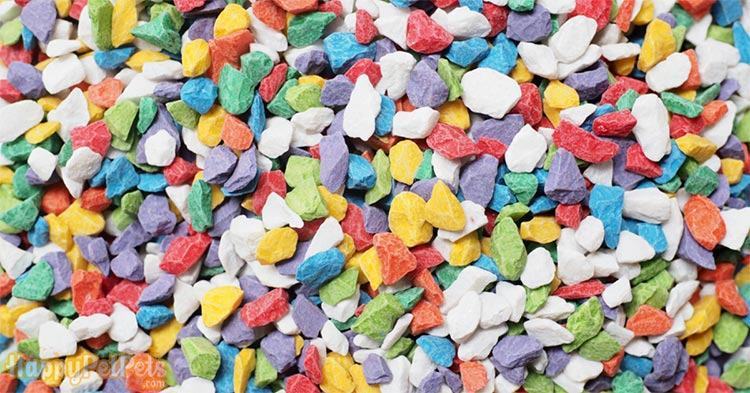
Not only supporting the tank cleanliness, but gravel also has lots of color which help you decorate the tank more convenient.
5. Do I Need to Clean Old Fish Tank Gravel
Gravel substrate maintains the water cleanliness because its space can hide all the uneaten food, waste and debris. Otherwise, this will make you neglect cleaning the gravel and turn the tank into a dangerous place for fish if it is too dirty than acceptable.
With gravel substrate, not only good bacteria can grown-up but also other microorganisms can live too. That is why you should clean old fish tank gravel to keep your fish in the best environment.
6. How Often Should I Clean Aquarium Gravel
You should clean the aquarium gravel at least once every two weeks. This cleaning stage can follow after the partial water change. Consider it will not cost you much time, you can do the gravel cleaning frequently, but each time only cleaning for 20-30% of the tank will be much better for your fish.
How to clean old aquarium gravel in three ways
A – How to Clean Old Aquarium Gravel With a Vacuum
Preparation:
- An aquarium vacuum with fish tank cleaning hose (a siphon or flexible plastic tube)
- A bucket or water faucet
- Freshwater with dechlorination liquid
- A thermometer
Performance:
Step 1: Disconnect every electrical equipment of the fish tank
- Before cleaning your old aquarium gravel, you should unplug the aquarium light, heater, filter and pump
- The vacuum duration is not long, so don’t worry about your fish
- You can clean fish tank gravel without removing water, fish or aquatic plants and aquarium decorations
Step 2: Get the vacuum ready with a plastic tube/priming ball/python
* Using a plastic tube:
- Place a bucket lower than the tank and its water level. The beneath bucket can get the used water
- Immerse the whole vacuum tube slowly into the water, make sure there is no air left inside the tube
- Cover a top of the tube with your thumb and take it out of the water, let the other open under the water
- With the covered one, put it into the placed bucket, then release the cover, old water will fall out until you cover the tube once again
* Using a priming ball:
- Set it up similar to a plastic tube
- When covering the tube end with your finger, also squeeze the ball and let it out to help the water drawing in
- Unplug the tube so that old water can fall into the placed bucket
* Using a python or other types of vacuum:
- A python needs to work with a water faucet, so you don’t need to place the bucket first
- Stick the python directly to the faucet, and submerge the tube end into the fish tank water
- The vacuum can start to work when you turn on the faucet
This preparation step is for turning on your vacuum and testing its function, not for taking all the water out.
Step 3: Start Vacuuming the Entire Aquarium Substrate
- As what you have prepared in step two, you should cover one of the tube’s ends with your thumb, let it deep in the bucket while the other should lay under the gravel substrate. In case you use sand material, place the tube end on the sand surface
- When finishing your setup, release your thumbs. Old dirty water with debris and waste along will fall down into the bucket through the tube
- Cover the tube end again if the pouring out water starts to be clear
- During this stage, the old gravel will shake and might get inside the tube, but it will back to the previous position when you stop the siphoning
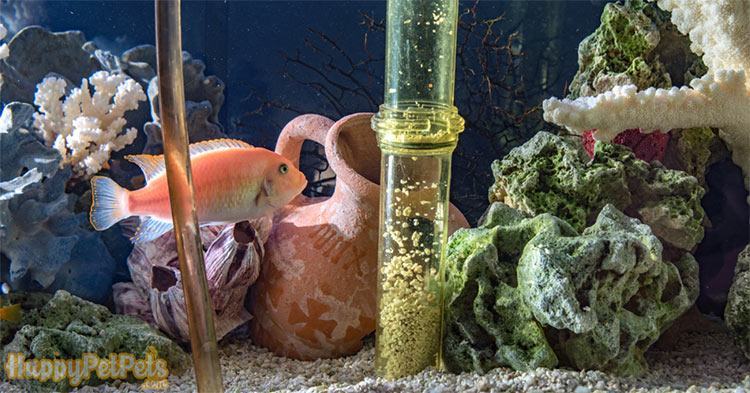
The gravel will shake a little bit inside the fish tank cleaning hose but it will be back at the previous position when you stop vacuuming
You can clean fish tank gravel without removing water all exist in the aquarium, just get rid of the dirty ones.
Step 4: Focusing More on the Special Parts
- After cleaning your fish tank generally, try to get closer with the dirtiest group of gravel you can see, especially cranny, log, rock and cave in the tank
- Repeat the vacuum stage as in step three
- You should keep the tube straight to not break out the whole debris part
- Try to clean the area that is 2 inches apart from the aquatic plants, since the organic waste is their food
Step 5: Stop Vacuuming a Part of Your Fish Tank is Clear
- You can stop vacuuming when the water level has dropped about one-third of the full height. This means you have cleaned 25-30% of the fish tank
- Do not clean all the tank, it is not good for the fish and plants
With this cleaning solution, you can know how to clean old aquarium gravel without taking all of the tank water out or affecting your fish, plants and tank decoration.
How to clean old aquarium gravel with a vacuum – this is the best way to clean gravel in a freshwater tank
B – How to Clean Fish Tank Gravel Without a Vacuum
#1. How do you clean new aquarium gravel
- You can wash the new gravel with warm or hotter water
- You should wash this only once with brand new gravels for the first time using it
- Other equipment and decorating patterns can be washed in the same way
#2. How to clean aquarium gravel with bleach
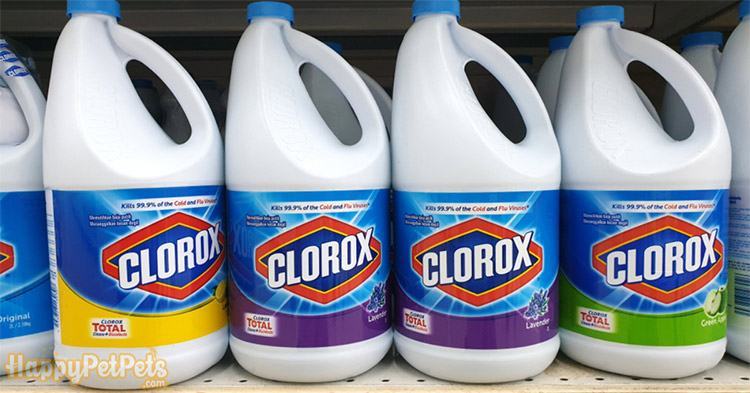
You must use bleach properly to not harm your fish and tank equipment
Bleach is a chemical liquid that is quite harmful to your fish if you do not clean the gravel completely or use it with the wrong proportion.
Although it contains a potential danger, using bleach is still good for how to clean aquarium gravel algae, filter hose, rock, plastic plants and the tank also. All you need is carefully clean the aquarium with bleach following this instruction to prevent harmful effects.
*How to clean aquarium gravel with bleach:
- Prepare an approximately 10% bleach liquid, which means mixing bleach and water in the proportion of 1:9, or less bleach concentration like 5% or 6% is enough.
- Only use bleach with water, since other chemicals can create more side effects
- Pour this bleach liquid into a pan of gravel
- Stir the gravel a little bit, then rinse off all the bleach
- You should NOT soak gravel and other patterns in bleach more than 15 minutes, or else the material may break due to the chemical reaction
- Clean the gravel with warm water, repeat this 3-5 times to make sure all the bleach be washed away
- Let the gravel dry naturally and apply them to the fish tank
#3. Cleaning fish tank with vinegar
Vinegar features safety cleaning and disinfecting functions, which is a better answer for ‘How do I disinfect my fish tank gravel’. Besides chemical bleach, you can use vinegar as a natural bleach to clean the fish tank easier without “hurting” the gravel and your fish.
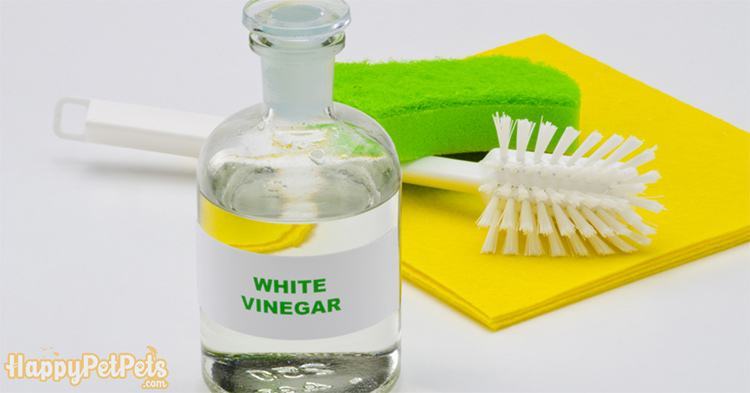
White vinegar and apple vinegar is a good detergent for cleaning old aquarium gravel and the entire fish tank
*How do I disinfect my aquarium with vinegar
- First, if you are using the tank for your fish, carefully unplug all fish tank devices and move the fish, as well as a part of using water to a bucket, the fish will stay there until you finish cleaning
- Move out all the decorations and aquatic plants
- Save some old gravel in a separate bowl, and put the left in a bigger bowl, wash them with clean water (old gravel contain lots of good bacteria, so you should not clean the entire gravel, it can kill all the necessary bacteria for your fish)
- You can use either apple vinegar or white distilled vinegar. Use them straightly to clean or make a mixture with vinegar and water in the proportion of 1:1
- Soak and clean the filter, heater, hose, pump, gravel and decorating things with vinegar. Other fish tank equipment can be soaked in vinegar for 24-48 hours, then you should scrub them and rinse again with clean water
- Gently wipe the tank with this vinegar liquid and wash them with water later, it is similar to how to clean an empty fish tank. Vinegar has a mild acid that can easily remove the calcium and hard deposit on the tank wall
- Finish cleaning aquarium rocks with vinegar, let all the things dry and put them back into the tank
C – Set Up a New Clean Aquarium for the Fish
Once you finish cleaning the aquarium with or without a vacuum, the next step is to make your aquarium a great living place for the fish again.
After cleaning fish tank with a vacuum:
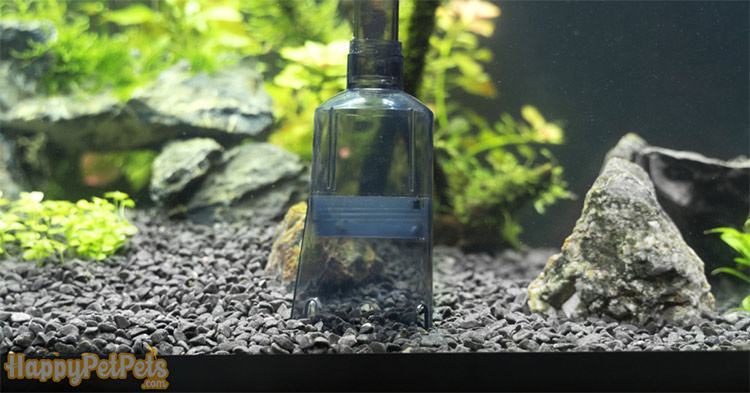
What is great about how to clean old aquarium gravel with a vacuum is it will not affect your fish tank decoration
- Prepare new freshwater with dechlorinating liquid to make sure they are safe enough for the fish
- Your fish are sensitive to the change in water temperature, so you should make sure the new water be at the same temperature with the existing water inside the tank
- Use a thermometer to compare the temperature of the water from two sources, then you can use the heater to help those two reaching the same heat
- Fill the tank with prepared water and turn on the equipment
After cleaning fish tank without a vacuum:
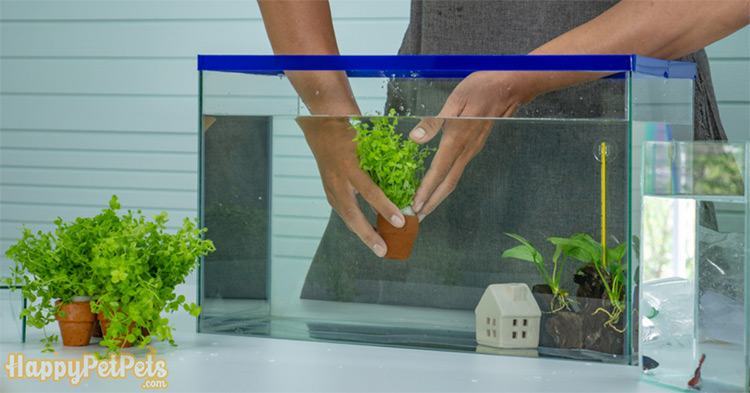
Fill in water, set the decoration and then put the fish back in the tank if you clean the gravel without a vacuum
- Mix old and clean gravel together, place them in the fish tank
- Prepare the new treated water as above and pour them into the tank
- Set up the aquatic plants and decorations
- Turn on the aquarium equipment
- Put the fish back into the aquarium
Besides using the treated water, you should care about the heat and nitrogen cycle of the tank. Adjust the suitable temperature with a heater for your fish or keep the fish tank warm enough without a heater and reduce ammonia level, as well as push the nitrogen cycle to work so that your fish can live in the best environment.
Conclusion
Know how to clean old aquarium gravel is a big help for your fish since you can clean the gravel and keep the fish develop better at the same time. Cleaning is not an easy task, too clean is also not good for your fish, either. Therefore, get the right way to clean the tank is what you need for the upcoming life with your fish.
I hope these cleaning solutions can support you to clean the old fish tank gravel without taking much time and effort, still get a great result as needed.
If you have any other better ideas about how to clean old aquarium gravel, or you are about some cleaning stage in this article, just feel free to leave a comment for us. We are happy to get your ideas or support you as much as we could.
If you find this helpful, don’t forget to like and share this for your relevant, we really appreciate that.
Related keywords:
how to clean canister filter, how often to clean canister filter, aquarium canister filter, how to clean a canister filter, how often should i clean my canister filter, cleaning canister filter, how often clean canister filter, how often to clean canister filter hoses, canister filter maintenance, fluval 407 canister filter maintenance, fish tank canister filter, how often should you clean a canister filter, how often should i clean my fluval canister filter, when to clean canister filter, how often should you clean canister filter, how often do you clean a canister filter, how often do you clean canister filter, how often to clean fluval canister filter, how often to clean a canister filter, how often to change canister filter media, how often should you clean your canister filter, how often to clean aquarium filter, how to clean fluval filter, how to change aquarium filter without losing bacteria, how to clean aquarium filter sponge
Similar Posts: https://happypetpets.com/category/aquariums-accessories/fish-tanks/
Source: https://happypetpets.com/

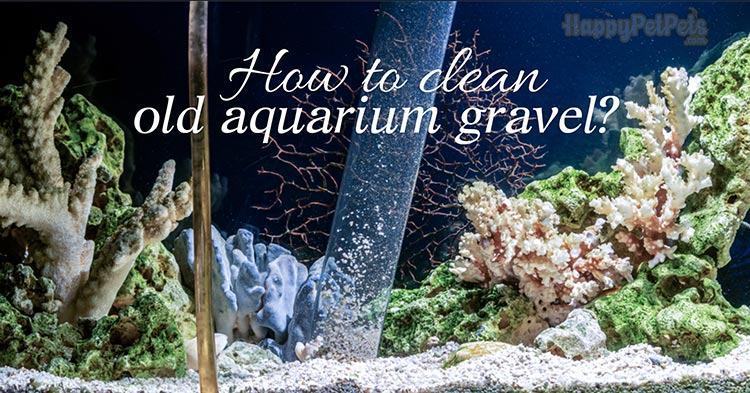

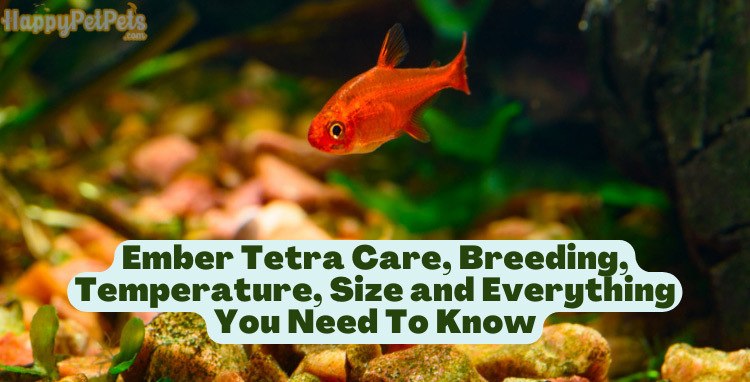
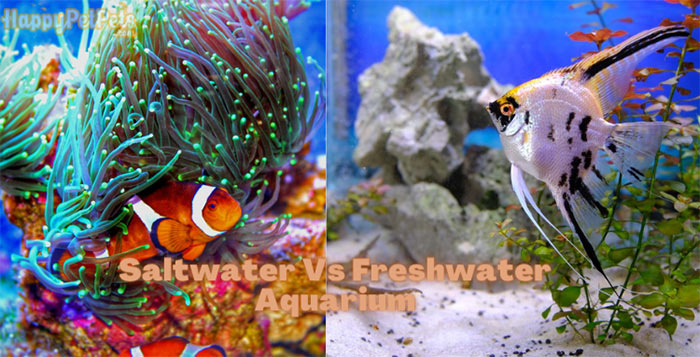


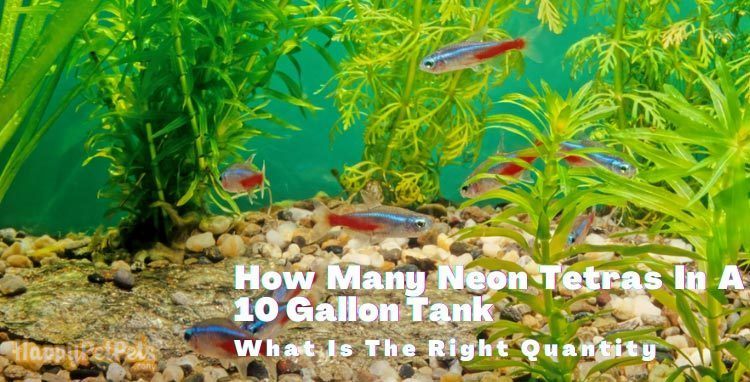
Excellent blog you have got here.. It’s difficult to find
quality writing like yours these days. I seriously appreciate people like you!
Take care!!
Amazing post. Articles that have meaningful and insightful
comments are more enjoyable, at least to me. It’s
interesting to read what other people thought and how it
relates to their clients, as their view could possibly assist you in the future.
Best regards,
Boswell Duke
Thanks so much for your post. I followed these steps above and the result was better than I expected.
Intriguing post. I’ve been pondering about this issue, so a debt
of gratitude is in order for posting. Entirely
cool post. Thanks!
Best regards,
Lunding Zacho
Steps to Clean Old Aquarium Gravel: Step one is the standard cleaning solution: about 10% bleach and 90% hot or warm water, or you can use a lower concentration of bleach to be safe for fish after that. The second step is to put the fish gravel in the pot plus the bleach solution, pour the water to cover the gravel. Soak the gravel for no more than a quarter of an hour, during which time you can stir to irritate the cleaning solution. The fourth step is to rinse the aquarium gravel and then dry it. Finally, return it to the aquarium.
Help full, thank you so much.